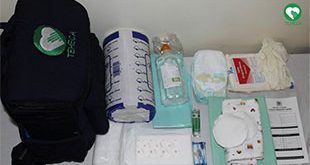
Kampala, Uganda | THE INDEPENDENT | Uganda has halted the use of hydroxychloroquine as studies to determine the drug’s effectiveness in treating COVID-19 are ongoing.
The drug has been used to treat some positive cases of the disease at some treatment facilities like Entebbe General Hospital. It was used in combination with antibiotics like azithromycin and painkillers where needed. But its use was stopped by the World Health Organisation after it was found to be ineffective in treating both mild and severe forms of the disease.
Lt. Col. Dr Henry Kyobe, an epidemiologist and also the COVID-19 incident manager says that they have also resorted to monitoring all people who test positive for the disease. The new approach will now focus on the use of Vitamin C in combination with zinc and azithromycin to manage cases.
“The he argument behind the hospitalization of patients is to make sure that we monitor them so that they do not slip into severe illness and if they do to make sure we can deal with the cases first,” he said.
Since drug trials into possible COVID-19 treatments begun, only two drugs have shown any kind of promise. Remdesivir which was initially developed for Ebola Virus disease has shown that it can help patients recover faster by reducing their recovery period by four days. The other is dexamethasone which can stop mortality in severe cases.
Another drug that is being tested and has shown promise is a cholesterol-lowering drug Fenofibrate which researchers say helps the body burn carbohydrates, reducing the fat accumulating inside the lung cells and stopping the virus from reproducing.
In May 2020, the health ministry said it would not stop using the drug based on recommendations from elsewhere. According to the ministry of health, despite the promise shown by other treatments, they will not use either Remdesivir or Dexamethasone to manage the disease.
Dr Misaki Wayengera, an epidemiologist and also the head of the COVID-19 Scientific ministerial committee says that none of the countries cases needs any of treatments. “We are carrying out our own studies so that we do not depend on studies elsewhere but also our cases are mild and we do not need the drugs. They are useful in severe cases,” he said.
As of yesterday, Uganda had a total of 1,077 recovered patients.
********
URN
 The Independent Uganda: You get the Truth we Pay the Price
The Independent Uganda: You get the Truth we Pay the Price




One of the biggest challenges of the developing world, are journalists who misreport. I wonder when and where this reporter got this from me, citing me as an epidemiologist ( forget that my speciality is clinical genetics).
My position on the use of HCQ can be found below:
https://m.facebook.com/story.php?story_fbid=10156998085456750&id=559586749
Hydroxychroloquine-HCQ: The Schrodinger cat in CoVID19 care
In 1927, the Solvay conference on electrons and quanta, was held-gathering a small cluster of the giants and founding fathers of quantum physics. During the evolving discourse on the nature and behaviours of an electron proposed by Werner Heisenberg….the wave (cloud) nature of his proposition hinted to the possibility that an electron could both be here, and there. That in itself introduced the likelihood of uncertainty. In casualty principal, that was an unacceptable phenomenon to Albert Einstein, despite similar implications of his earlier description of the wave behaviors of Robert Oppenheimer’s quanta.
To demonstrate the principle of uncertainty regarding the behaviour of electrons (and presumably other small particles), an Austrian Physicist- Erwin Schrodinger, present at the conference conjured a theoretical experiment involving the famous ‘Schrodinger cat’ in 1935. In the experiment, a bottle of cyanide was situated in the same box as a live cat, whose poisoning was to be triggered by a quantum gun. Schrodinger argued, that according to Heinseberg’s uncertainty principle, once the electrons from the gun triggered the release of cyanide from the bottle, at that instant, there would be both a dead and alive cat in the box.
The emerging evidence surrounding the relevance of using HCQ for the management of CoVID19, is nothing but a replica of the very ‘Schrodinger cat’. For example, this week as WHO once again stopped two of its Solidarity arms involving the use of HCQ and LPV/r for having no benefit, Arshad S, et al ( 2020) showed in a large trial that treatment with hydroxychloroquine alone and in combination with azithromycin was associated with reduction in COVID-19 associated mortality. These “benefit vs. no benefit’ conclusions have gone on since the 1st studies on the same emerged in Wuhan, China 6 months ago. So which is the alive cat and where is the dead one, for both are represented at the same instant.
I argue that the answer lies in differences in the biological purpose, for which HCQ is applied. The non specific antiviral effects of HCQ on SARS-CoV2 in-vitro, mediated by lowering cytoplasmic and therefore endoplasmic pH levels, is inadequate to completely obliterate if not halt viral infectivity alone, and might need to be supplemented by other drugs as a combination, to suffice for the purpose. HCQ, however, has another role-immune modulation. In this application (for which the drug is used in Uganda), its given early when patients have no symptoms yet, so as to halt the onset or atleast reduce (dumpen) the effects of the cytokine storm. One can thus extrapolate, that use of HCQ in already hospitalized with severe CoVID19 and established effects of the cytokine storm, will note change the outcomes. The drug has to be used early, as a prophylactic against the CS.
In the absence of an over arching appreciation of this fundamental virology and pharmacology, it will forever elude our faith in the reality of the co-existence of both an effective benefit, and no benefit for HCQ in CoVID19 patient care. This illustrates the problem of clinical trial data applied to every day basic science principles, in the same manner the Copenhagen interpretation of quantum mechanics did, when applied to everyday objects.
Misaki WAYENGERA, MD, PhD
Chair, MoH Ministerial SAC